Athens
At the Erechtheion, part of the Acropolis Complex.
We touched down in Athens rather refreshed from the snoozes we’d managed on our Easyjet flight from London’s Gatwiock airport. An hour long bus ride took us from the airport to Syntagma Square in the heart of Athens which was only a short stroll away to the Acropolis House Hotel where I had made accommodation arrangements. The place is old-fashioned and suitably gracious and we had excellent service from the personnel–Jasmine and Andreas–who went out of their way to be kind and helpful and informative.
 After a short nap, we set out to see the Highlights of the National Archaeological Museum. But we were waylaid en route by a travel agent who sought to sell us an expensive package tour and, in the process, informed us that our intended itinerary would not work as the ferry schedule is altered completely after November 1 when the official tourist season ends in Greece. Grateful for the information, we set about altering our travel plans in keeping with ferry routes and schedules, then booked our ferry tickets, called the hotels to modify our dates of arrival and departure and then finally boarded a trolley to get to the museum. The ride was novel and exciting and by the time we arrived there, we were all reved up and ready to go.
After a short nap, we set out to see the Highlights of the National Archaeological Museum. But we were waylaid en route by a travel agent who sought to sell us an expensive package tour and, in the process, informed us that our intended itinerary would not work as the ferry schedule is altered completely after November 1 when the official tourist season ends in Greece. Grateful for the information, we set about altering our travel plans in keeping with ferry routes and schedules, then booked our ferry tickets, called the hotels to modify our dates of arrival and departure and then finally boarded a trolley to get to the museum. The ride was novel and exciting and by the time we arrived there, we were all reved up and ready to go.
The sheer size of the museum and its collection is overwhelming and we were grateful for Lonely Planet that pointed out the most important items. We saw the Mask of Agamemnon, the Bronze of Zeus (that some say is Poseidon), the gigantic Kouri–so similar to the one at the Metropolitan Museum in New York that I show on my own Highlights tour–the Cycladic Figures that so influenced Picasso and the Modernists, the frescoes excavated from Akrotiri on Santorini and several other significant classical works.
Riding on the trolley back to our hotel, we were charmed by the energy and vitality of contemporary Athens. We sought out a taverna called Paradisio where local Greek patrons were tucking into plates of roasted sardines. We chose to eat a Greek Salad (so good we ordered a Greek salad with every meal from then on) and a Moussaka that was superb. The best part of this rather unpretentious place was that it was only steps away from our hotel and it was a joy to be able to get back into our comfortable bed in just a hop, a skip and a jump.
First impressions of Athens? Admirable indeed.
The next day, on one of America’s most historic days–the election of our first African-American President–Llew and I awoke in the very cradle of Democracy–Athens, Greece–and rejoiced. “He did it, babe”, Llew shouted to me through the bathroom door in our hotel in Athens after he received the news from a Greek TV station. We high-fived each other, then joined a jubilant band of local Athenians at breakfast, all of whom were celebrating the great win of Barack Obama and, hopefully, the beginning of Change in America.
The Acropolis, at last!
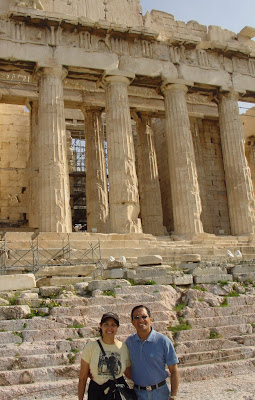 We were at the base of the Acropolis is ten minutes, strolling in leisurely fashion through Plaka, the area that looks completely different by daylight. Through the quaintest little Greek village we passed and joined the busloads of late-season tourists trooping towards the towering monuments at the top of the world’s most famous urban mountain. Twelve euros covered entry into a number of attractions and Lonely Planet made it very easy for us to tour the complex without the need of a pricey personal guide.
We were at the base of the Acropolis is ten minutes, strolling in leisurely fashion through Plaka, the area that looks completely different by daylight. Through the quaintest little Greek village we passed and joined the busloads of late-season tourists trooping towards the towering monuments at the top of the world’s most famous urban mountain. Twelve euros covered entry into a number of attractions and Lonely Planet made it very easy for us to tour the complex without the need of a pricey personal guide.
 We passed by the awesome Theater of Herodes Atticus where we have seen so many famous performers (Yanni, Charlotte Church, etc.) wow audiences in recent years. It must be a stunning venue at night when the lights are turned on and the rest of Athens sleeps quietly just beyond the stage walls.
We passed by the awesome Theater of Herodes Atticus where we have seen so many famous performers (Yanni, Charlotte Church, etc.) wow audiences in recent years. It must be a stunning venue at night when the lights are turned on and the rest of Athens sleeps quietly just beyond the stage walls.
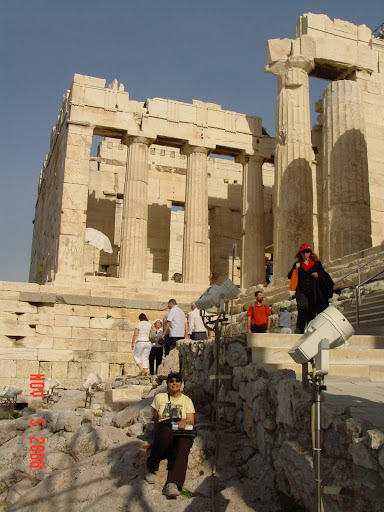 Next, we advanced towards the Prophylea and the Temple of Athena Nike with its high steps and its endless scaffolding, for conservation is an on-going process at these ancient sites. Through the arches and into the main courtyard, the Parthenon finally came into sight. Of course, we spent ages examining it in loving detail, noting the acquisitiveness that led to the hacking of sculpture from the central frieze by Lord Elgin in what has become an endless controversy between Greece and the UK. It became clear to me then that he did not ‘rescue’ these sculptures in any way. They were not buried hundreds of feet beneath the earth as the treasures of Tutankhamen were, for instance, or the city of Pompeii. These marbles were just cut clean off the pediment and transported to England to the best of my knowledge on a bare whim. I realized that I ought to read more to educate myself on why and how the Elgin Marbles are now in the British Museum. At any rate, the two remaining sculptures–one on each end, of a seated youth, and a horse’s head–that are still on the structure are deeply stirring and I simply couldn’t take enough pictures of these works “in situ”.
Next, we advanced towards the Prophylea and the Temple of Athena Nike with its high steps and its endless scaffolding, for conservation is an on-going process at these ancient sites. Through the arches and into the main courtyard, the Parthenon finally came into sight. Of course, we spent ages examining it in loving detail, noting the acquisitiveness that led to the hacking of sculpture from the central frieze by Lord Elgin in what has become an endless controversy between Greece and the UK. It became clear to me then that he did not ‘rescue’ these sculptures in any way. They were not buried hundreds of feet beneath the earth as the treasures of Tutankhamen were, for instance, or the city of Pompeii. These marbles were just cut clean off the pediment and transported to England to the best of my knowledge on a bare whim. I realized that I ought to read more to educate myself on why and how the Elgin Marbles are now in the British Museum. At any rate, the two remaining sculptures–one on each end, of a seated youth, and a horse’s head–that are still on the structure are deeply stirring and I simply couldn’t take enough pictures of these works “in situ”.
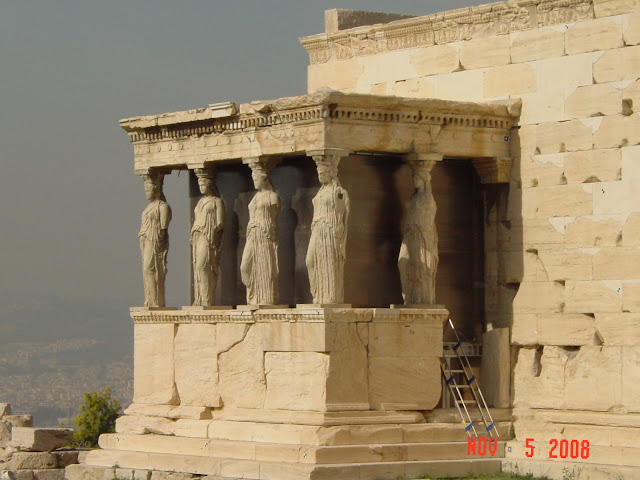
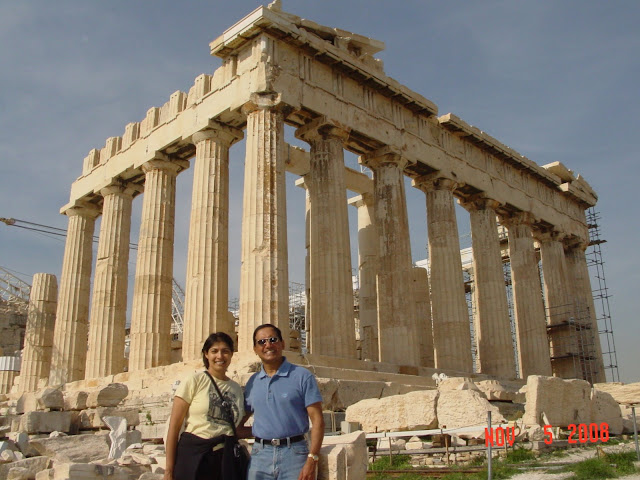 We then made our way towards the Erechtheion, another beautiful temple of Poseidon that features the Karyatids, a series of six sculpted women that are charmingly graceful.
We then made our way towards the Erechtheion, another beautiful temple of Poseidon that features the Karyatids, a series of six sculpted women that are charmingly graceful.
Here again, five of the originals can be seen in the Acropolis Museum while the fifth original is in the British Museum in London. Plaster of Paris replicas of the five that are in Athens are placed on the building and they make a striking backdrop for pictures. Greece must be so enormously proud of these visions of Pericles that have allowed so many such buildings to survive, albeit in ruined form.
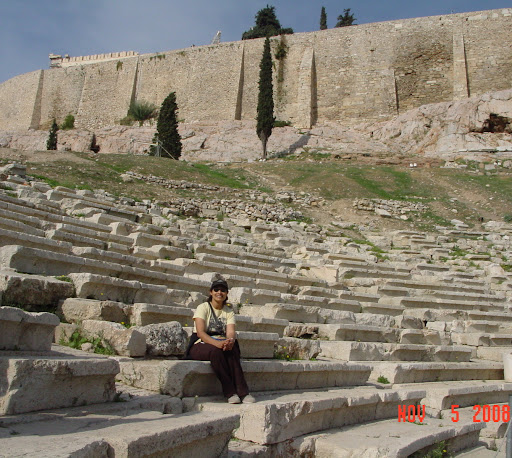 Just at the foot of the Acropolis is the Theater of Dionysus, an enormous complex that is now in the process of refurbishment. Here it is possible to see the original venue on which the plays of the Greek tragedians, Aeschyles, Sophocles and Euripedes were performed with the works of Aristophanes providing comic relief. Here were created the classical principles of dramatic composition upon which playwrights the world over have depended. The lion-footed throne on which the high priest sat to watch the shows is still in place and I was deeply stirred by my rambles through the Pentellic marble spectator stands of this strangely atmospheric place.
Just at the foot of the Acropolis is the Theater of Dionysus, an enormous complex that is now in the process of refurbishment. Here it is possible to see the original venue on which the plays of the Greek tragedians, Aeschyles, Sophocles and Euripedes were performed with the works of Aristophanes providing comic relief. Here were created the classical principles of dramatic composition upon which playwrights the world over have depended. The lion-footed throne on which the high priest sat to watch the shows is still in place and I was deeply stirred by my rambles through the Pentellic marble spectator stands of this strangely atmospheric place.
The original Acropolis Museum which was a part of the Parthenon has been shut down and a superb new and very modern building has taken its place a few blocks away. Llew and I walked quickly there to see the original Karyatids only to discover that they were not yet in place as only part of the museum has been opened to the public. Instead, we were treated to a special exhibit containing the items that were acquired fraudulently by such great international museums as the Metropolitan in New York and the J. Paul Getty in Malibu, California, that have now been returned to Italy. These pieces, which include the famous Euphronious Krater about which I had learned while training at the Met, were on loan to the Athens Museum and were on display for a limited period before they find a permanent home in Italy. I was so thrilled to see the Euphronius Krater again–it was like running into an old friend! Indeed, I had wanted to visit the Met and bid goodbye to it at the time that the newspapers in New York were full of the news of its departure to Italy but had not been able to find the time–and little did I expect that I would see it again on foreign shores! That is the beauty of travel too, isn’t it? You never know what or who you will run into when you set sail for distant lands. I cannot wait to tell my fellow docents at the Met about my serendipitous discovery.
The Ancient Agora:
 After a delicious Greek Salad lunch on one of the wayside restaurants that line Adrianou just outside the gates of the Ancient Agora, Llew and I launched on to the next phase of our sight seeing–an examination of the Temple of Hephthasos, a classical Greek temple that stands almost intact on the great grounds that once constituted the most important part of official Athens. It was in the Agora (marketplace) that St. Paul disputed with his critics endlessly while trying to find converts to Christianity; it was here that Socrates was imprisoned and accepted the cup of hemlock that led to his heroic death; it was here that merchants, bankers and financiers created the economic glory that was Greece.
After a delicious Greek Salad lunch on one of the wayside restaurants that line Adrianou just outside the gates of the Ancient Agora, Llew and I launched on to the next phase of our sight seeing–an examination of the Temple of Hephthasos, a classical Greek temple that stands almost intact on the great grounds that once constituted the most important part of official Athens. It was in the Agora (marketplace) that St. Paul disputed with his critics endlessly while trying to find converts to Christianity; it was here that Socrates was imprisoned and accepted the cup of hemlock that led to his heroic death; it was here that merchants, bankers and financiers created the economic glory that was Greece.
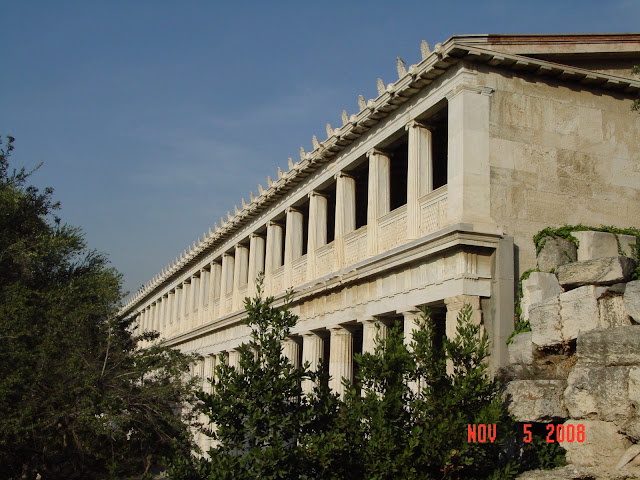 Only three buildings are in a good state–the Stoa of Attalos, the Church of the Holy Apostles built in honor of St. Paul and full of lovely Byzantine mosaics and the Temple of Hephthasos. The rest of the Agora is in dismal condition, most of it lying in ruins in the shape of columns and blocks and red terracotta tiles–somewhat like the Roman Forum in Rome, only in worse condition.
Only three buildings are in a good state–the Stoa of Attalos, the Church of the Holy Apostles built in honor of St. Paul and full of lovely Byzantine mosaics and the Temple of Hephthasos. The rest of the Agora is in dismal condition, most of it lying in ruins in the shape of columns and blocks and red terracotta tiles–somewhat like the Roman Forum in Rome, only in worse condition.
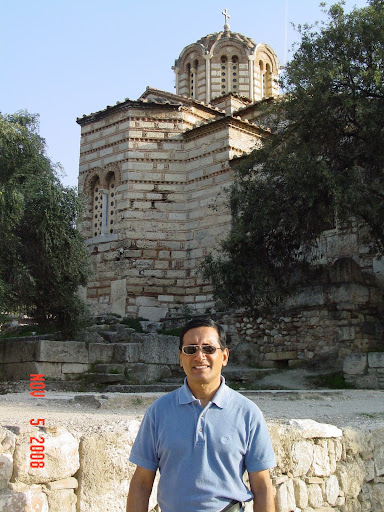
 By this point in our day, my feet were fatigued and I needed to return to our hotel for a long rest. Upon awaking from a siesta, we went out in search of dinner and chanced upon Thannasis, a wayside restaurant at Monastiraki, which Lonely Planet had extolled as having the best kebabs in the city. And they were quite correct indeed. Our meal was simple–lamb kebabs with roasted tomato and onions wrapped in pita bread, but so delicious and so laughably cheap we actually spent less that three euros for the lot. For dessert, we picked up Sokolatina, a chocolate mousse pastry that had been recommended to us by Llew’s former Greek colleague Ted Francis. And it was simply fabulous!
By this point in our day, my feet were fatigued and I needed to return to our hotel for a long rest. Upon awaking from a siesta, we went out in search of dinner and chanced upon Thannasis, a wayside restaurant at Monastiraki, which Lonely Planet had extolled as having the best kebabs in the city. And they were quite correct indeed. Our meal was simple–lamb kebabs with roasted tomato and onions wrapped in pita bread, but so delicious and so laughably cheap we actually spent less that three euros for the lot. For dessert, we picked up Sokolatina, a chocolate mousse pastry that had been recommended to us by Llew’s former Greek colleague Ted Francis. And it was simply fabulous!
After a day that had been both historic and deeply fascinating, we packed up our few belongings and got ready for our early morning departure, the next day, for the ferry cruise to Mykonnos. Athens are just amazing and we were glad that our itinerary included one more day in the city on our way back when we hoped to explore those bits of it that we had yet to traverse.
Roman, Neo-Classical and Byzantine Athens:
We returned to Athens after touring the Cyclades on our last day in Greece. It had been such a blissful ten days that Llew and are were loath to return to routine, even though, comfortingly, that routine would be, for me at least, in London.
Though friends had told us that Athens can be covered in a day and a half, we so loved the city and its many varied quarters, some of which we had yet to explore, that we had several places lined up to see before we returned home. However, I woke up feeling awful and for some inexplicable reason, had no appetite or energy to tackle anything. Llew breakfasted alone while I took a rest and it was only after he had checked out, an hour later, that I stirred and found the enthusiasm to go ahead with our plans.
 Our first stop was Hadrian’s Arch and the Temple of Olympian Zeus in “Roman Athens”. These remnants of Rome’s occupation of Greece take the form of large monuments in rather dismal shape. While the Arch is quite impressive, it is the few standing columns of the Temple that catch the eye–mainly because they are so tall. This temple was once the largest in Greece and though today only 17 columns remain, they do give an idea of how stupendous a sight it might have presented to contemporary Athenians.
Our first stop was Hadrian’s Arch and the Temple of Olympian Zeus in “Roman Athens”. These remnants of Rome’s occupation of Greece take the form of large monuments in rather dismal shape. While the Arch is quite impressive, it is the few standing columns of the Temple that catch the eye–mainly because they are so tall. This temple was once the largest in Greece and though today only 17 columns remain, they do give an idea of how stupendous a sight it might have presented to contemporary Athenians.
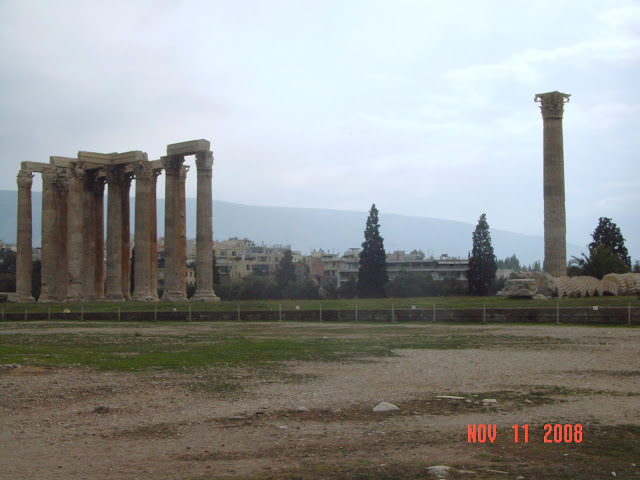 Then, we found ourselves skirting the Temple’s precincts and making our way towards the National Gardens to see the Zappeion, at the suggestion of Ted Francis, a corporate attorney in the States, who was once Llew’s colleague and is now a good friend.
Then, we found ourselves skirting the Temple’s precincts and making our way towards the National Gardens to see the Zappeion, at the suggestion of Ted Francis, a corporate attorney in the States, who was once Llew’s colleague and is now a good friend.
 Ted has Greek heritage and Llew had made sure to ask him for his travel tips before he left the States. One of the places that Ted thought we should see was the Zappeion and I am very grateful he suggested this, not just because it allowed us to explore the interior of a very unique and very imposing Neo-Classical Building in the middle of the city, but because we also had the opportunity to explore the ‘lungs’ of Athens in the huge and very well-maintained garden. Inside the building–which is odd because it appears like a rectangular structure on the outside but is really circular within–that was used as the press center for the Athens Olympics in 2004, there was a publicity event on for the forthcoming Special Olympics and the press was busy setting up cameras and lights.
Ted has Greek heritage and Llew had made sure to ask him for his travel tips before he left the States. One of the places that Ted thought we should see was the Zappeion and I am very grateful he suggested this, not just because it allowed us to explore the interior of a very unique and very imposing Neo-Classical Building in the middle of the city, but because we also had the opportunity to explore the ‘lungs’ of Athens in the huge and very well-maintained garden. Inside the building–which is odd because it appears like a rectangular structure on the outside but is really circular within–that was used as the press center for the Athens Olympics in 2004, there was a publicity event on for the forthcoming Special Olympics and the press was busy setting up cameras and lights.
 Having viewed the Zappaeion, we went in search of the Athens Olympic Stadium of 2004 and though finding it on foot following a map was something of a challenge, we were quite overwhelmed when we did see it. For the stadium is massive and entirely constructed of marble. The five international Olympic rings dominate the structure and make a marvelous backdrop for the pictures that visitors feel compelled to take. This was the stadium into which the finalists of the marathon entered at the end of their long run and we could just imagine what it might have been like–thousands of cheering fans greeting the winners and screaming during their victory lap.
Having viewed the Zappaeion, we went in search of the Athens Olympic Stadium of 2004 and though finding it on foot following a map was something of a challenge, we were quite overwhelmed when we did see it. For the stadium is massive and entirely constructed of marble. The five international Olympic rings dominate the structure and make a marvelous backdrop for the pictures that visitors feel compelled to take. This was the stadium into which the finalists of the marathon entered at the end of their long run and we could just imagine what it might have been like–thousands of cheering fans greeting the winners and screaming during their victory lap.
Walking through the lovely flower-beds of the garden, we arrived at the main thoroughfare, in time to take in the rituals of the 12 noon “Changing of the Guards” ceremony at Syntagma Square. This is very similar to the ceremony in London except that instead of wearing funny bear-skin hats, these Greek guards wear funny frilly skirts and large pom-pom shoes and march in the fashion that is distinctly reminiscent of John Cleese in Fawlty Towers in the episode in which he attempts to imitate a Nazi soldier. Needless to say, the moves of these guards brought a great deal of laughter–some of it suppressed, much of it not–and photo opportunities for the assembled tourists who arrive at the tolling of each hour. The handsome Parliament Building makes a very fitting backdrop to this ceremony which is performed on a platform that contains the Tomb of an Unknown Soldier. It is meant to be a solemn and dignified ritual and I was sorry that so many young tourists found it amusing.
After resting for a bit, we walked along the main avenue towards the three Neo-Classical Buildings that one cannot fail to notice as one rides in the city’s trolley buses. These comprise the Athens Academy, the University of Athens and the Central Library. Each building is more beautiful than the other, the Academy fronted by the statues of Socrates and Aristotle and crowned by those of Apollo and Artemis. At the University, we were delighted to have strayed into the midst of a graduation ceremony where lovely young ladies all decked out in summer floral dresses and chiffony frills with either improbably high heeled boots or delicate stilettos, bore large bouquets of flowers in their hands and posed for pictures with their loving relatives. It was a lovely sight to see and we were so glad to receive this spontaneous glimpse into contemporary Athenian culture.
A few moments later, having covered Roman Athens and Neo-Classical Athens, we crossed the street and went in search of Byzantine Athens represented by the ancient churches that dot its oldest quarters. Llew was especially keen that I visit the 11th century Church of Kapnikarea that stands smack in the middle of Ermou, one of the city’s busiest shopping areas and which he had seen earlier on one of his solo rambles. This tiny church is so old that when you enter it, you almost expect its walls to crumble in your hands.
It was time for lunch and we hurried again to Thannasis which was doing roaring business at midday. It was our last chance to enjoy a really good meal and we opted for a Greek Salad and the Moussaka, which was served in the terracotta pot in which it had been baked and was easily one of the best we have ever tasted. Over Mythos beer, this meal went down like a dream and we were so glad that we would take back superb memories of Greek food through the many varied restaurants we had visited on the recommendation of Lonely Planet.
On the way back to our hotel to pick up our bags, we did have a chance to see one more old church, the large Cathedral which stands right next to the smaller 12th century Church of Agios Eleftherios. All Byzantine Greek churches have a similar design inside and exude an air of religious formality through the use of swinging incense-burners and glass chandeliers.
It was, sadly, time for us to think of returning to our hotel as our flight left at 8pm. We wanted to arrive at the airport by 6 pm, which meant that we needed to get on the metro by 5 pm. A last stroll through Monastriki allowed us to pick up some inexpensive souvenirs trinkets for relatives and a scarf for me depicting the glory of classical Greek architecture, before we arrived at Acropolis House and picked up our baggage. En route to the metro stop, we could not resist stopping at Syntagma Square to pick up some edible goodies to carry back home–Greek pistachios, mixed nut brittle studded with sesame seeds, and some more sokolatina (chocolate mousse pastry) from our favorite confectionery at the corner.
On the metro back to the airport, we ran into the group of four Asians–two couples from Hongkong–whom we had seen repeatedly on our travels. Together, we entered the train that spirited us away to the airport and on to our Easyjet flight which landed at Luton airport in London at about 11 am. Because there wasn’t much traffic on the motorways at that time of night, we did manage to get to the Baker Street Tube stop before the last train left and the system closed for the night. We were home twenty minutes later, holding close to our hearts, some indelible memories of the ten blissful days we had spent in Greece–the cradle of Western civilization.
Bon Voyage!
To read about our visit to Delphi, please click on the link.
